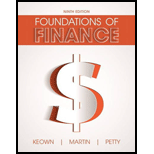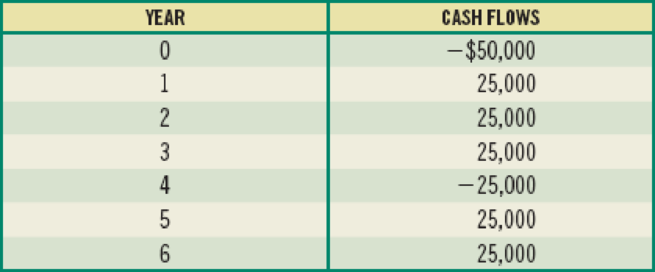
Foundations of Finance (9th Edition) (Pearson Series in Finance)
9th Edition
ISBN: 9780134083285
Author: Arthur J. Keown, John D. Martin, J. William Petty
Publisher: PEARSON
expand_more
expand_more
format_list_bulleted
Concept explainers
Textbook Question
Chapter 10, Problem 15SP
(MIRR calculation) Calculate the MIRR given the following

Should the project be accepted?
Expert Solution & Answer
Want to see the full answer?
Check out a sample textbook solution
Students have asked these similar questions
Ends Feb 23
Explain in detail what is Risk as defined for financial assets and what is Beta? Also
discuss in detail what is the Capital Asset Pricing Model (CAPM) and its purpose.
The slope parameter ß1 measures the change in annual salary, in thousands of dollars, when return on equity increases by one percentage point. Because a higher roe is good for the company, we think ß1 > 0.The data set CEOSAL1 contains information on 209 CEOs for the year 1990; these data were obtained from Business Week (5/6/91). In this sample, the average annual salary is $1,281,120, with the smallest and largest being $223,000 and $14,822,000, respectively. The average return on equity for the years 1988, 1989, and 1990 is 17.18%, with the smallest and largest values being 0.5% and 56.3%, respectively.Using the data in CEOSAL1, the OLS regression line relating salary to roe is :
For the population of people in the workforce in 1976, let y = wage, where wage is measured in dollars per hour. Thus, for a particular person, if wage = 6.75, the hourly wage is $6.75. Let x = educ denote years of schooling; for example, educ =12 corresponds to a complete high school education. Because the average wage in the sample is $5.90, the Consumer Price Index indicates that this amount is equivalent to $24.90 in 2016 dollars.Using the data in WAGE1 where n = 526 individuals, we obtain the following OLS regression line (or sample regression function):
Chapter 10 Solutions
Foundations of Finance (9th Edition) (Pearson Series in Finance)
Ch. 10 - Why is capital budgeting such an important...Ch. 10 - What are the disadvantages of using the payback...Ch. 10 - Prob. 4RQCh. 10 - What are mutually exclusive projects? Why might...Ch. 10 - Prob. 6RQCh. 10 - When might two mutually exclusive projects having...Ch. 10 - Prob. 1SPCh. 10 - Prob. 2SPCh. 10 - Prob. 3SPCh. 10 - (NPV, PI, and IRR calculations) Fijisawa Inc. is...
Ch. 10 - (Payback period, NPV, PI, and IRR calculations)...Ch. 10 - (NPV, PI, and IRR calculations) You are...Ch. 10 - (Payback period calculations) You are considering...Ch. 10 - (NPV with varying required rates of return)...Ch. 10 - Prob. 9SPCh. 10 - (NPV with varying required rates of return) Big...Ch. 10 - (NPV with different required rates of return)...Ch. 10 - (IRR with uneven cash flows) The Tiffin Barker...Ch. 10 - (NPV calculation) Calculate the NPV given the...Ch. 10 - (NPV calculation) Calculate the NPV given the...Ch. 10 - (MIRR calculation) Calculate the MIRR given the...Ch. 10 - (PI calculation) Calculate the PI given the...Ch. 10 - (Discounted payback period) Gios Restaurants is...Ch. 10 - (Discounted payback period) You are considering a...Ch. 10 - (Discounted payback period) Assuming an...Ch. 10 - (IRR) Jella Cosmetics is considering a project...Ch. 10 - (IRR) Your investment advisor has offered you an...Ch. 10 - (IRR, payback, and calculating a missing cash...Ch. 10 - (Discounted payback period) Sheinhardt Wig Company...Ch. 10 - (IRR of uneven cash-flow stream) Microwave Oven...Ch. 10 - (MIRR) Dunder Mifflin Paper Company is considering...Ch. 10 - (MIRR calculation) Arties Wrestling Stuff is...Ch. 10 - (Capital rationing) The Cowboy Hat Company of...Ch. 10 - Prob. 28SPCh. 10 - (Size-disparity problem) The D. Dorner Farms...Ch. 10 - (Replacement chains) Destination Hotels currently...Ch. 10 - Prob. 33SPCh. 10 - Prob. 34SPCh. 10 - Why is the capital-budgeting process so important?Ch. 10 - Prob. 2MCCh. 10 - What is the payback period on each project? If...Ch. 10 - What are the criticisms of the payback period?Ch. 10 - Prob. 5MCCh. 10 - Prob. 6MCCh. 10 - Prob. 7MCCh. 10 - Prob. 8MCCh. 10 - Prob. 9MCCh. 10 - Determine the IRR for each project. Should either...Ch. 10 - How does a change in the required rate of return...Ch. 10 - Caledonia is considering two investments with...
Knowledge Booster
Learn more about
Need a deep-dive on the concept behind this application? Look no further. Learn more about this topic, finance and related others by exploring similar questions and additional content below.Similar questions
- Define the following: Callable bond Puttable bond Zero-coupon bond Premium bond Discount bond Crossover bonds Even though most corporate bonds in the United States make coupon payments semiannually, bonds issued elsewhere often have annual coupon payments. Suppose a German company issues a bond with a par value of EUR 1,000, 15 years to maturity, a coupon rate of 7.2%. If the yield to maturity is 6.3%, what is the current price of the bond? Rhiannon Corporation has bonds on the market with 13 years to maturity, a YTM of 7.6%, a par value of $1,000, a current market price of $1,075. The bonds make semiannual payments. What must the coupon rate be on these bonds? What would be coupon rate if the current market price is $962.68? What would be the coupon rate if the bonds make quarterly payments? Suppose that a bond has a face value of $1,000 and a YTM of 8% per annum. If the bond pays monthly coupons with an annual coupon rate of 9.6%, what will be the current price of…arrow_forwardWildcat, Incorporated, has estimated sales (in millions) for the next four quarters as follows: Q1 Q2 Q3 Sales $ 195 $ 215 $ 235 Q4 $ 265 Sales for the first quarter of the following year are projected at $210 million. Accounts receivable at the beginning of the year were $83 million. Wildcat has a 45-day collection period. Wildcat's purchases from suppliers in a quarter are equal to 50 percent of the next quarter's forecast sales, and suppliers are normally paid in 36 days. Wages, taxes, and other expenses run about 20 percent of sales. Interest and dividends are $18 million per quarter. Wildcat plans a major capital outlay in the second quarter of $98 million. Finally, the company started the year with a $84 million cash balance and wishes to maintain a $40 million minimum balance. a-1. Assume that Wildcat can borrow any needed funds on a short-term basis at a rate of 3 percent per quarter and can invest any excess funds in short-term marketable securities at a rate of 2 percent per…arrow_forwardConsider the following two bonds: Bond A Bond B Face value $1,000 $1,000 Coupon rate (annual) 8% 8% YTM 9% 7% Maturity 10 years 10 years Price (PV) ? ? Calculate the price for each bond. What is the primary factor affecting the prices of the bonds? Indicate which bond is premium and which one is discount. Is there any relationship between the YTM and the coupon rate in case of premium/discount bonds? Now, consider the following two bonds: Bond X Bond Y Face value $1,000 $1,000 Coupon rate (annual) 8% 8% YTM 11% 11% Maturity 5 years 10 years Price (PV) ? ? Calculate the price for each bond. What is the relationship between bond price and maturity, all else equal? A bond with a par value of $1,000 and a maturity of 8 years is selling for $925. If the annual coupon rate is 7%, what’s the yield on the bond? What would be the yield if the bond had semiannual payments?…arrow_forward
- Don't used hand raitingarrow_forwardDon't used Ai solutionarrow_forwardAssume an investor deposits $116,000 in a professionally managed account. One year later, the account has grown in value to $136,000 and the investor withdraws $43,000. At the end of the second year, the account value is $107,000. No other additions or withdrawals were made. During the same two years, the risk-free rate remained constant at 3.94 percent and a relevant benchmark earned 9.58 percent the first year and 6.00 percent the second. Calculate geometric average of holding period returns over two years. (You need to calculate IRR of cash flows over two years.) Round the answer to two decimals in percentage form.arrow_forward
- Please help with the problem 5-49.arrow_forwardPlease help with these questionsarrow_forwardIn 1895, the first U.S. Putting Green Championship was held. The winner's prize money was $170. In 2022, the winner's check was $3,950,000. a. What was the percentage increase per year in the winner's check over this period? Note: Do not round intermediate calculations and enter your answer as a percent rounded to 2 decimal places, e.g., 32.16. b. If the winner's prize increases at the same rate, what will it be in 2053? Note: Do not round intermediate calculations and enter your answer as a percent rounded to 2 decimal places, e.g., 32.16. a. Increase per year b. Winners prize in 2053 %arrow_forward
arrow_back_ios
SEE MORE QUESTIONS
arrow_forward_ios
Recommended textbooks for you
 Intermediate Financial Management (MindTap Course...FinanceISBN:9781337395083Author:Eugene F. Brigham, Phillip R. DavesPublisher:Cengage Learning
Intermediate Financial Management (MindTap Course...FinanceISBN:9781337395083Author:Eugene F. Brigham, Phillip R. DavesPublisher:Cengage Learning

Intermediate Financial Management (MindTap Course...
Finance
ISBN:9781337395083
Author:Eugene F. Brigham, Phillip R. Daves
Publisher:Cengage Learning

Capital Budgeting Introduction & Calculations Step-by-Step -PV, FV, NPV, IRR, Payback, Simple R of R; Author: Accounting Step by Step;https://www.youtube.com/watch?v=hyBw-NnAkHY;License: Standard Youtube License